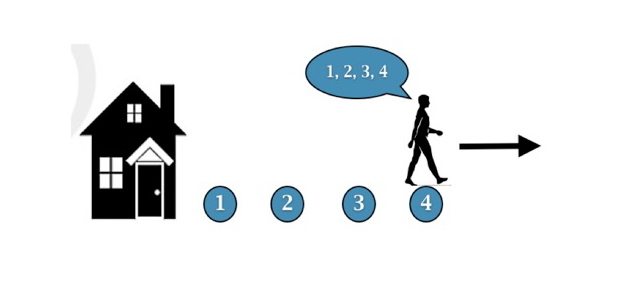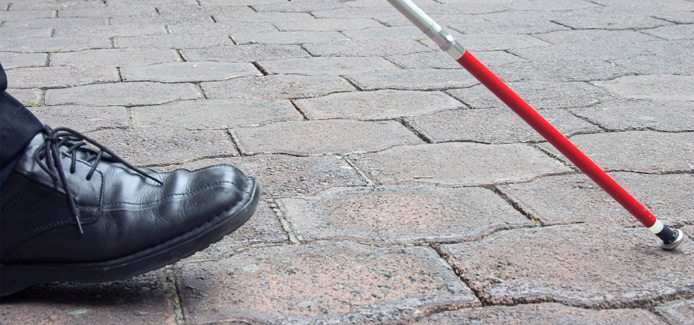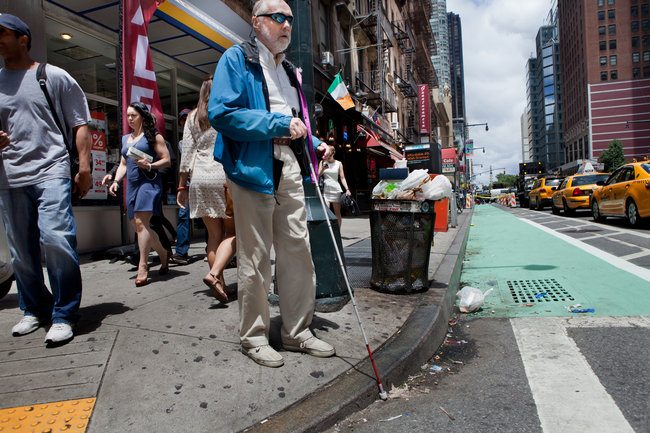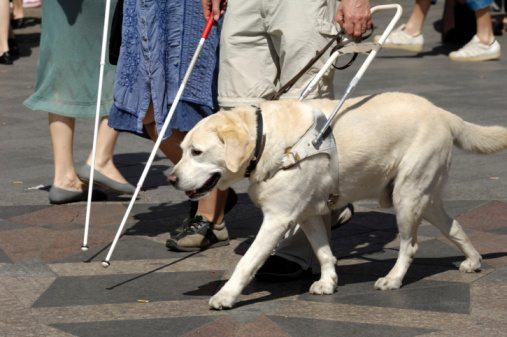Mobility Tips For People Who Are Blind
Published onHow Can People Who Are Blind Get Around On Their Own Better?
Before I get started with this piece, I’d like to give you a short heads-up…… many cities around the U.S. have local organizations that teach proper mobility skills and traveling safety lessons for blind and visually impaired individuals. I seriously recommend you take this training.
I’m sure you’ll find my mobility tips useful since I’m writing from my own personal experience but it certainly couldn’t hurt to get lessons from a trained professional as well. A link near the end of this article will take you to directory page with contact info for organizations who offer orientation & mobility skills training.
Counting Steps
Let’s start with counting steps. Sounds fun, right? Trust me, it’s not fun at all and you really shouldn’t bother using this method because it doesn’t work. For example, let’s say it is 7,531 steps from my front door to the office. I’m walking along and my phone rings just as I get to the 5,397th step; I lose my count and then I have to walk all the way back home and start counting again over again. Just kidding; I wouldn’t really start all over again but you get the point on exactly why counting steps is not used by many people.
So, How Should it be Done?
First get your cane or dog guide and make sure both of you have used the bathroom; especially if you’re an old man like me ;). Several techniques are in play for me when I travel, just like for any of you I’m sure.
Timing
Timing is a big one. If I am walking in a familiar area and it feels like I have gone too far then it’s time for me to stop and figure out where I am. I equate it to sighted people who are driving and suddenly realize they’ve gone too far and missed the street they were supposed to turn down.
Here are some things I do to get myself back on track in situations like this.
1. Listen
Most importantly; I use my ears. The most essential thing for a blind traveler to do is constantly listening and making yourself aware of all you can hear around you. Always be aware of how sounds can change and/or echo while you’re walking. Some examples of this are traffic, open areas, trees and the echo of walls or other objects.
If you’re not already familiar with how sound can change, try this. Go stand in your shower with the water off and the curtain or door closed. Listen closely to the sounds of the room you for a while and then open the curtain and listen how the sound changes. It’s a very nominal change but if you practice listening in this manner as you’re out walking, you’ll quickly become a master of hearing the echoes of trees, fences and buildings.
2. Touch
Next is sense of touch and it’s just as important as sound.
Focus on what your feet are feeling as you walk. This is crucial, especially when you’re walking down a busy street. Your feet will easily recognize what kind of surface you’re walking on as you go along and help keep you on track. If you take a wrong step and notice you went from a hard to a soft surface, chances are you’ve stepped off the sidewalk and need to step back onto it before continuing. Either that or you’ve stepped into a pile of it; tee-hee ;). But I digress…….
Use landmarks. Your sense of touch also comes in handy with noticing familiar landmarks as you walk. Let’s say for example that you know of three bus stop benches along you route. Reaching your hand out to touch each one as you pass by helps you gauge your progress more precisely.
3. Smell
Now let’s talk about smell. You may ask “what the heck does smelling have to do with getting around safely”? Trust me, utilizing your sense of smell can be a huge help, particularly if you walk the same route each day. Once you’re familiar with where you’re traveling, smells can be a big asset in helping you determine exactly where you are at any given time. If you smell grass or vegetation you’re most likely near a park or open field but if you smell a lot of exhaust you’re probably near a parking lot or a traffic light.
Crossing Streets
When it comes time to cross a street, you need to make sure that you are lined up straight on the curb. I do this by finding the curve of the corner with my cane or foot and then slide either direction until I’m on the straightest part I can find. After positioning yourself to walk, listen intently for traffic moving past the crosswalk. When you hear the cars slow to a stop you’ll know it’s safe to cross. Take the first 2 or 3 steps very slowly just to be safe and then get your butt in gear so the light doesn’t change while you’re in the middle of the street. Although I’m sure 99% of drivers have enough courtesy to wait for you to finish crossing before they take-off; it’s still wise to move quickly as you cross streets. Better safe than sorry right?
If you’re walking with a sighted person and you aren’t concerned with learning the route, go ahead and take their arm just above the elbow so you can feel their body movements as they step up, down or to the side. Never allow your sighted friend take your arm because that will put you ahead of them and could lead to trips, falls or whatever.
Shopping
One of the more challenging experiences for me is going to the mall or some other large store that has several exits. It’s vital to remember which door I entered because I want to leave through the same door when I’m done shopping. So how the heck does someone who can’t see figure out which door they’ve entered through?
The first two things I do when I enter a store is stop and listen. I listen for unique sounds that will still be there when it’s time to leave; like an audible advertisement playing for a specific product or the noises that come from certain products themselves. As I’m sure you can imagine, this part is easier in a tech or hardware supply store than a department store.
After listening; I start touching some of the items near the entrance. This way if I do get lost in the store, I can ask somebody in the store to guide me back to men’s shoes department or at least point me in the right direction. You’ll find most people are more than happy to help in situations like this; except maybe if you’re an old man asking someone to guide you back to the women’s lingerie department ;). You’ll probably experience some awkward hesitation from folks if that happens, lol!
Likewise, smell can tell you if a snack bar is anywhere near the entrance. The strong smells of perfume or leather are also great indicators as to what department you’re in.
Let’s Walk
Now that we know how to best utilize all the information through our available senses, let’s rock on.
My suggestion is that you start out in familiar areas so you can get comfortable walking independently. If at first you feel better learning a route with a sighted person, use your cane instead of having your companion guide you. Ask them to talk to you about what’s around the area while you walk along (i.e. trees, open areas, landmarks, businesses, etc.).
There’s so much more I could write about on this topic but I didn’t want to make it so long that people lose interest. I hope this gives you some insight and understanding as to how we get around and helps others who are blind get out-&-about independently more often.
I might add that I’ve walked into several walls, poles, tripped off curbs and even taken a header down steps. However, I always got up and never gave up; and neither should you. It’s important to be able to laugh at yourself when you make mistakes; life is much easier to take if you have a sense of humor.
A few more great mobility resources you should checkout if you plan to walk independently more often:
- Orientation and Mobility Skills Training Directory – VisionAware.org
- Directory of Guide Dog Training Programs in the United States and Worldwide
- Canes and Mobility Aid Retailers: Independent Living Aids and Maxi-Aids
- Mobile Apps: Plenty of Mobility Apps are available via the iTunes App Store and Google Play for smart phones that will audibly speak the route to you as you walk.
Categorized in: Accessibility, Health and Wellness, Informational, Opinion
This post was written by









Comments are closed here.